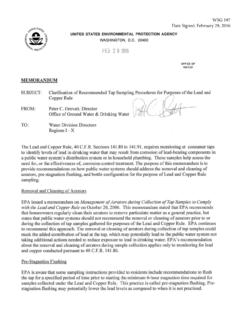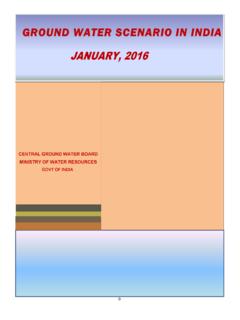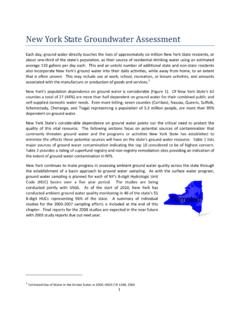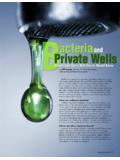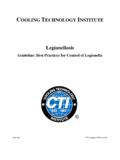Transcription of Appendix 13.2: Paint Chip Sampling - HUD.gov / U.S ...
1 App 1 Appendix : Paint Chip SamplingDust Sampling must always be done before Paint chip Sampling in order to minimize the prospect of cross-sample contamination. Paint chip Sampling is a destructive method that may release a small quantity of lead dust. Although it is preferable to collect Paint chip samples from inconspicuous areas, the occupant must always be notified that Paint chip Sampling may be necessary. This is particularly necessary in some risk assessments. 1. Paint Chip Sampling Tools and Materials A. Sharp stainless steel Paint scraper. B. Disposable wipes for cleaning Paint scraper.
2 C. Non-sterilized non-powdered disposable gloves. D. Hard-shelled containers (such as non-sterilized 50-ml polypropylene centrifuge tubes) that can be rinsed quantitatively for Paint chip samples if results are to be reported in mg/cm2. Zip-type sealable baggies can be used only if results are to be reported in g/g or percent by weight. E. Collection device (clean creased piece of paper or cleanable tray). F. Field Sampling and laboratory submittal forms. G. Tape measure or ruler (if results are reported in mg/cm2). H. Ladder. I. Plastic trash bags. J. Flashlight. K. Adhesive tape.
3 L. Heat gun or other heat source operating below 1100 F to soften the Paint before removal. 2. Containment A. Method One: Plastic Sheeting Underneath Sampling Area A clean sheet of plastic measuring four feet by four feet should be placed under the area to be sampled to capture any Paint chips that are not captured by the collection device or creased piece of paper. Any visible Paint chips falling to the plastic should be included in the sample. Dispose of the plastic after each sample is collected by placing the sheeting in a trash bag. Do not throw away the plastic at the dwelling. Wet wipes may be used to clean the area.
4 B. Method Two: Glovebag Approach. If further containment is deemed necessary, a glovebag approach may be used. A durable sheet of plastic is loosely taped to the surface to be sampled, with a Paint scraper, collection device, and shipment container housed inside the plastic. There should be enough play in the plastic to permit a scraping motion without dislodging the tape holding the App 2 Appendix to the surface. Large plastic baggies can be used in lieu of the sheet of plastic if Paint chips are to be shipped to the lab in plastic baggies. Properly conducted, this method completely seals the surface during the actual scraping operation.
5 A four by four foot sheet of plastic is still required under the glove bag to capture any debris that falls to the ground during the glove bag removal. The tape should be slowly removed from the surface to avoid lifting any additional Paint off of the surface. 3. Paint Sample Collection The Paint chip sample need not be more than 2-4 square inches in size (consult with the laboratory for the optional size). Persons collecting Paint chips should wear new disposable gloves for each sample. The most common Paint Sampling method is to scrape Paint directly off the substrate. The goal is to remove all layers of Paint equally, but none of the substrate.
6 A heat gun should be used to soften the Paint before removal to reduce the chances of including substrate with the sample and to help prevent sample loss. Including substrate in the sample will dilute the lead content if results are reported in g/g or weight percent. Hold the heat gun no closer than six inches from the surface. Do not scorch the Paint . Discontinue heating as soon as softening or blistering is observed. If you are only interested in layers that are not in good condition, you would only sample the damaged a razor-sharp scraper to remove Paint from the substrate. Paint samples collected in this fashion are usually reported as a mass concentration in g/g or % lead only.
7 The sample may be placed in a baggie or a hard-shelled container for shipment to the laboratory. If the area sampled is measured exactly, and all the Paint within that area can be removed and collected, it is possible to also report the results as the area concentration in mg/cm2, also known as the loading. All of the sample must be placed in a hard-shelled container for shipment to the laboratory. The hard-shelled container is used since the laboratory will analyze the entire sample submitted. The exact dimensions of the area sampled must be recorded on the field Sampling form. If you will report the sample results as a loading, in mg/cm2, you must tell the laboratory in advance and have it report the weight of the whole sample, the mass concentration and the loading; in this case, including a small amount of substrate in the sample is Composite Paint Chip Sample Collection Whenever composite Sampling is contemplated, consult with the analytical laboratory to determine if the laboratory is capable of analyzing composite samples and, if so, what wipes should be used and what annotation they add to analysis reports of composite samples.
8 NLLAP accredited labs are required to note on the report that composite wipe analyses are not covered by their accreditation. This may cause problems with the admissibility of the data in any subsequent legal chip samples may be composited by collecting individual subsamples from different surfaces that are kept in separate sample containers, with appropriate directions to the laboratory concerning which samples are to be composited. Each subsample should contain enough material to perform a second individual analysis if needed. No more than 5 subsamples should be included in the same sample container or zip-type sealable baggie.
9 If both single-surface and composite samples are collected side-by-side, the individual samples can be submitted for analysis without returning to the dwelling if the composite result is above the composite standard. If the laboratory does not analyze the entire composite sample, it must use a validated homogenizing technique to ensure that all sub-samples are completely mixed 3 Appendix results are reported as a loading in mg/cm2, each subsample should be exactly the same size in surface area. If results are reported in weight percent or g/g, the laboratory should ensure equal weights of each subsample is composited (weighing is done in a laboratory).
10 The result is then compared to the standard for lead-based Paint divided by the number of sub-samples (the composite standard). If the result is above this number, one or more of the samples may be above the standard. Each sub-sample should be reanalyzed individually in this case. If the result is below this number, none of the sub-samples can contain lead above the standard. 5. Cleanup and Repair A. All settled dust generated must be cleaned up using wet wipes. B. The surface can be resealed with new Paint if necessary. If desired, apply spackling and/or new Paint to repair the area where Paint was removed.










